We all love spending time with our furry friends. They make great companions while out in nature and can easily keep up no matter where we take them. Over the water is no exception.
Many dog breeds are designed for swimming and have historically done well working or playing in and near water.
One thing to look into is the type and size of kayak that you intend to use because there will be weight limits, and some of the best water dogs are quite large (e.g., Newfoundland).
Regardless of your lifestyle, there is a dog that is perfect for you and ready to take on the waves. We will explore the best dog breeds for kayaking with the ideal temperament and breed characteristics.
These breeds thoroughly enjoy water-based sports. In addition to the breeds, we will include the basics of training your dog to travel in a kayak.
Table of Contents
The 20 Best Dogs for Kayaking
This is not an exhaustive list of the best dogs for kayaking, but we worked to present a list that has a variety of sizes and temperaments while still being water dogs.
This will allow you to look for one that will fit well with your family and lifestyle.
American Water Spaniel
Temperament: These charming dogs are generally quite happy and content. These dogs are stubborn but also eager to please.
Height: They average between 15 and 18 inches.
Weight: Males are usually larger at 30 to 45 pounds while females can be 25 to 40 pounds
Lifespan: Average lifespan is 10 to 14 years.
Breed characteristics: The American Water Spaniel is a mid-sized dog breed that is considered a sports breed. They are native to the Midwest lakes area, and they are both energetic and love water.
The breed was meant to be a hunting dog that was taken out on canoes and does quite well on water vehicles.
Exercise Requirements: This breed needs to have something to do with their time, or else they can start chewing and barking. They do best with a large fenced yard to play in, and they love obedience and agility training.
Training Requirements: They do best if you give them some basic social training as young puppies, but their general desire to please makes them one of the easier breeds to train.
Barbet

Temperament: This sweet-natured breed is friendly and very smart.
Height: They average between 19 and 24.5 inches.
Weight: The breed weight is around 35 to 65 pounds, with the females sometimes being smaller in stature.
Lifespan: Average lifespan is 12 to 14 years.
Breed characteristics: The Barbet is a sports breed of medium size that was bred to be a French water dog, and long thick curls characterize its looks.
They are very athletic and social animals. This breed is strong, intelligent, and loves to swim.
Exercise Requirements: The Barbet enjoys regular walks several times a day and does best with a large fenced yard to play in.
They are not as active as some of the other dogs on this list, and although they enjoy doing athletic activities, they are also perfectly comfortable lounging around the house.
Training Requirements: This is an even-tempered breed, and they take to training quite well as long as it is within a friendly and reassuring environment; otherwise, they may spook.
It might be easier to get them used to the kayak at home before trying the lake.
Boykin Spaniel
Temperament: This is an incredibly friendly dog that is eager to learn and loveable.
Height: Males are usually between 15.5 and 18 inches while the females are slightly smaller at 14 to 16.5 inches.
Weight: Males are around 30 to 40 pounds, while females are 25 to 35 pounds.
Lifespan: Average lifespan is around 10 to 15 years.
Breed characteristics: This medium-sized sports breed loves to please and enjoys swimming and athletic activities.
The Boykin Spaniel is a mellow mannered dog that makes a great house pet while still being incredibly active. Originally bred as a hunting and retrieving dog, these spaniels love the water.
Exercise Requirements: Boykin’s require a lot of daily activity to keep them happy, and they do best in households that do a lot of outdoor activities like hiking.
They also do very well in obedience and agility training and love to please their owner.
Training Requirements: This breed is intelligent, loving, loyal, and enjoys learning new tricks.
It is recommended that you give them basic social training as a puppy to make sure they know how to interact appropriately with strangers because they can be shy.
Chesapeake Bay Retriever

Temperament: This sensitive dog is affectionate, bright, and loves to make new friends.
Height: Males are approximately 23 to 26 inches, while females are between 21 and 24 inches.
Weight: Males weigh in at a hefty 65 to 80 pounds while the females are 55 to 70 pounds.
Lifespan: The average lifespan is between 10 and 13 years.
Breed characteristics: The Chesapeake Bay Retriever is an incredibly smart, large-sized dog that has been bred for generations to excel at duck hunting.
In addition to loving the water, being loving companions, and enjoying all types of outdoor activity, the Chesapeake Bay Retriever also has a waterproof coat.
Exercise Requirements: Hiking, running, obedience training, and tracking are all things that keep this fiercely intelligent and energized breed happy.
They need to stay active and mentally challenged; otherwise, they may become destructive and loud.
Training Requirements: Social and obedience training as a puppy is highly recommended for this breed.
They may otherwise be hard to contain thanks to their high energy level.
Curly-Coated Retriever
Temperament: This confident breed is brilliant, proud, and can be wary of strangers.
Height: Males are between 25 and 27 inches while females are 23 to 25 inches.
Weight: The breed is generally 60 to 95 pounds.
Lifespan: The average lifespan is between 10 and 12 years.
Breed characteristics: This large swimming dog is used for hunting and athletic sporting events. The Curly-Coated Retriever is incredibly intelligent and likes to be challenged.
This dog breed is able to be independent though they are loving and gentle. They may get bored due to their intelligence if they are left with nothing to do for too long.
They are a beautiful dog with short curly fur and a tapered head.
Exercise Requirements: Curly-Coated Retrievers do great running around outdoors or lazing about the house. They are an easy, laid-back breed.
Training Requirements: This breed does best with firm but kind training techniques; otherwise, they may scare off the whole idea, so when introducing them to the kayak, be sure to give them plenty of encouragement and affection.
English Setter
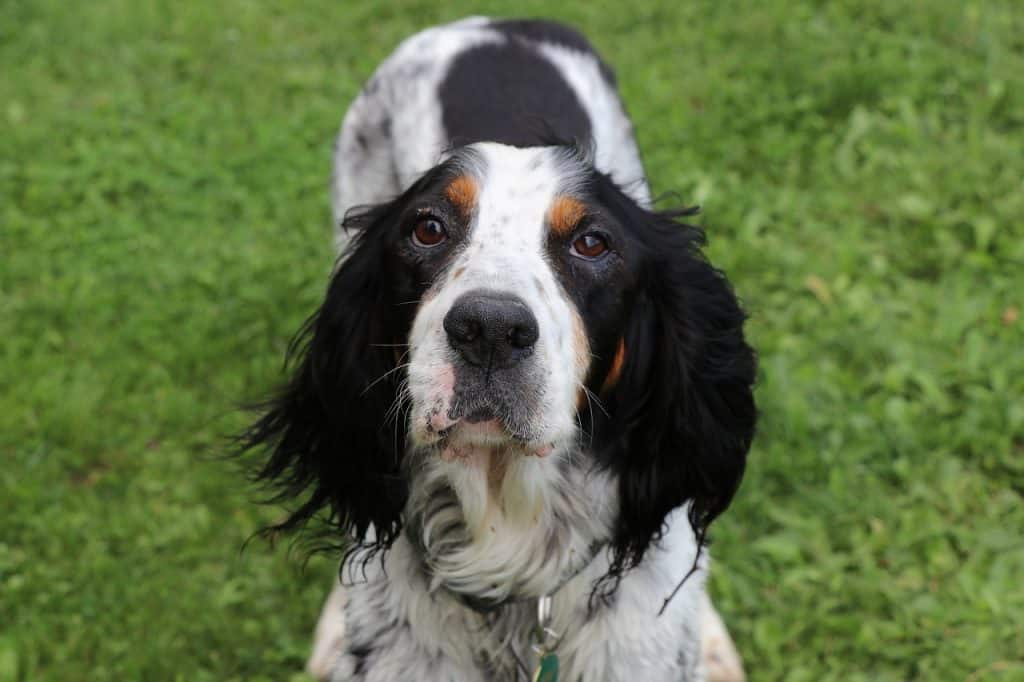
Temperament: This is a mellow breed that is friendly, happy, and loving.
Height: Males are 25 to 27 inches, and females are 23 to 25 inches.
Weight: Males are usually 65 to 80 pounds, while females are around 45 to 55 pounds.
Lifespan: The average lifespan is 12 years.
Breed characteristics: Most people are familiar with the medium-sized English Setter, which is frequently seen in shows and sporting events.
They are fair tempered and love people. These British hunting dogs were bred to be familiar in all different terrains, and they are comfortable in and around water.
They have a long speckled coat, and their stunning looks set them apart.
Exercise Requirements: These highly energetic dogs love to go on daily runs, jogs, and bicycle runs. When possible, it is best to make sure they have a large fenced in area to play.
Training Requirements: This breed is very sensitive and needs to be trained using positive reinforcement instead of admonishments. It works best to start teaching them early and be consistent during training.
Lagotto Romagnolo
Temperament: This even-tempered breed is affectionate and undemanding.
Height: Males are between 17 and 19 inches while females are 16 to 18 inches.
Weight: Males are 28.5 to 35 pounds, while females are 24 to 31 pounds.
Lifespan: They have a longer lifespan at between 15 and 17 years.
Breed characteristics: These medium-sized Italian sporting dogs are beautiful and intelligent.
The Lagotto Romagnolo was initially bred to sniff out expensive truffles, and that same smarts and drive allow them to make excellent athletic dogs.
Exercise Requirements: This breed requires both mental and physical stimulation to stay healthy and happy. In other words, be sure to get them daily exercise as you would with any dog breed.
Training Requirements: Early socialization and obedience training are essential to ensure that this breed stays well-adjusted while growing.
Standard Poodle
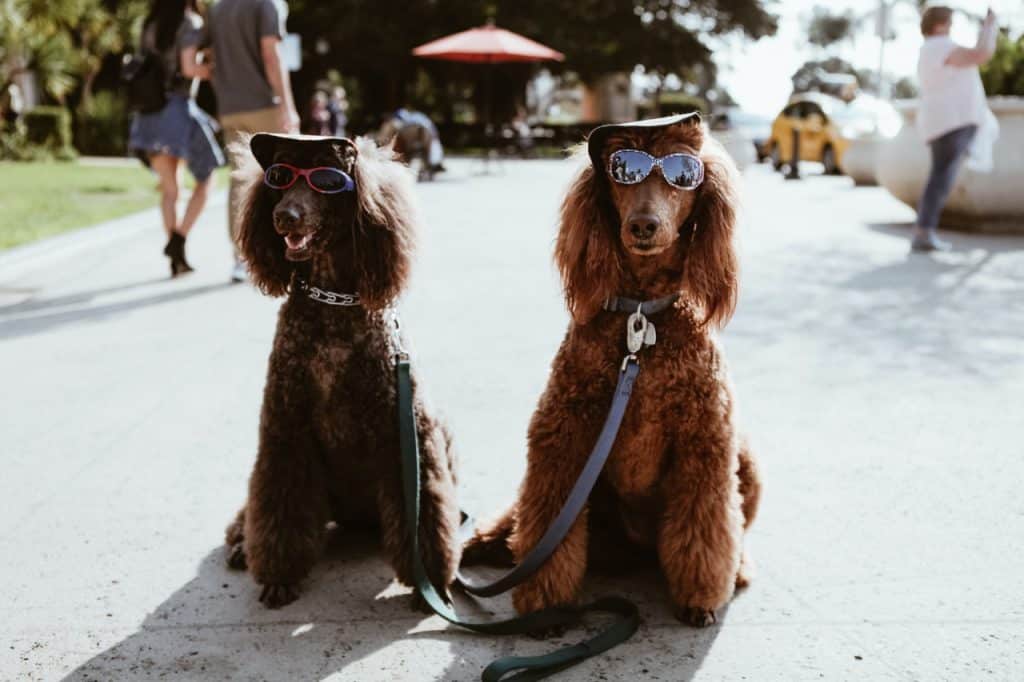
Temperament: This proud breed is smart, happy, and likes to stay active.
Height: The breed comes in various sizes, but the Standard is over 15 inches.
Weight: Males are 60 to 70 pounds, and females are 40 to 50 pounds.
Lifespan: Average lifespan is between 10 and 18 years.
Breed characteristics: The Standard Poodle is one of the smartest and all-around accomplished breeds.
Despite not being a sport dog, they are able to keep up with most athletic activities and enjoy accomplishing tasks.
They are on the edge between medium and large but have a long, thin frame.
Exercise Requirements: Standard poodles require high energy activities every day. They need to be both mentally and physically stimulated.
Training Requirements: Because of their intelligence, they are easy to train.
Otterhound
Temperament: This even-tempered dog is loud, lovable, and affectionate.
Height: Males are around 27 inches, and females are 24 inches.
Weight: One of the largest dogs on this list, the male Otterhound grows to approximately 115 pounds while the female is smaller at 80 pounds.
Lifespan: Average lifespan is 10 to 13 years.
Breed characteristics: Originally bred for otter hunting, the Otterhound is a fantastic water dog. It has webbed feet, shaggy waterproof fur, and loves to swim.
They have broad shoulders and are able to swim for long periods without resting. These loving dogs make excellent pets and exceptional adventure buddies out on the water.
Exercise Requirements: Otterhounds might need to be prompted to exercise. Despite their high energy reserves, they will often laze instead of self-exercise.
Training Requirements: They are very alert and responsive but can be quite sensitive. You want to train using positive reinforcement. Otterhounds can also be quite stubborn, so patience is critical.
Golden Retriever
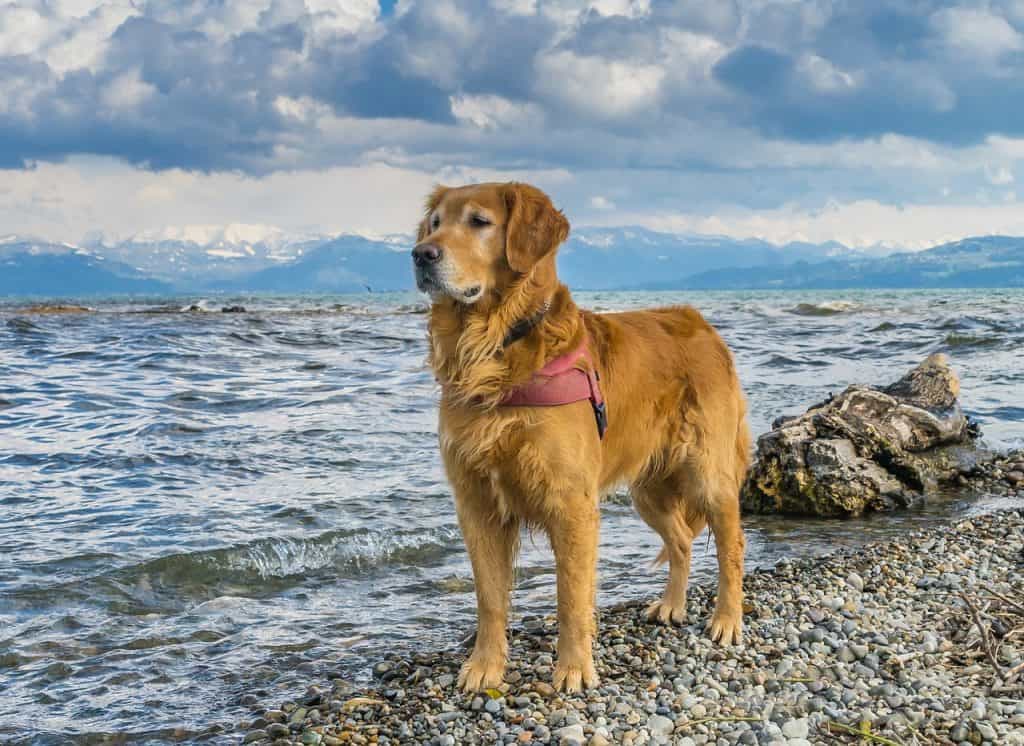
Temperament: This smart breed is devoted, kind, affectionate, and always ready to learn.
Height: Males are 23 to 24 inches, and females are 21.5 to 22.5 inches.
Weight: Males weigh around 65 to 75 pounds, while females are 55 to 65 pounds.
Lifespan: Average lifespan is 10 to 12 years.
Breed characteristics: The Golden Retriever is one of the most loved dog breeds around the world and is also highly athletic.
This large sporting dog enjoys the water and is incredibly obedient. They are an ideal size for tandem or solo kayaks.
Exercise Requirements: Daily walks or a large fenced yard to play in are necessary to keep your Golden Retriever from barking, digging, or chewing out of boredom.
Training Requirements: Early training and consistency are essential when it comes to teaching this breed. You will want to correct any bad habits before it becomes a problem when training them to ride in a kayak.
Labrador Retriever
Temperament: These friendly dogs are active, outgoing, and love attention.
Height: The males are 22.5 to 24.5 inches, while females are around 21.5 to 23.5 inches.
Weight: Most males are 65 to 80 pounds, and females are 55 to 70 pounds.
Lifespan: Average lifespan is between 10 and 12 years.
Breed characteristics: Another common breed of water dog, the Labrador Retriever, is excellent at hunting, swimming, and other athletic activities. This large sports breed is able to keep up with any outdoor activity.
They are quite friendly with people, other animals, and enjoy new experiences. They come in chocolate, black, and blond colors with sort of thick fur.
Exercise Requirements: This breed can get quite destructive if they are not exercised enough daily. Playing in the yard or multiple walks are necessary. They also excel in agility training.
Training Requirements: These dogs are smart, but need to be socialized early in order to grow into well-mannered dogs. They are easy to teach new skills.
Portuguese Water Dog
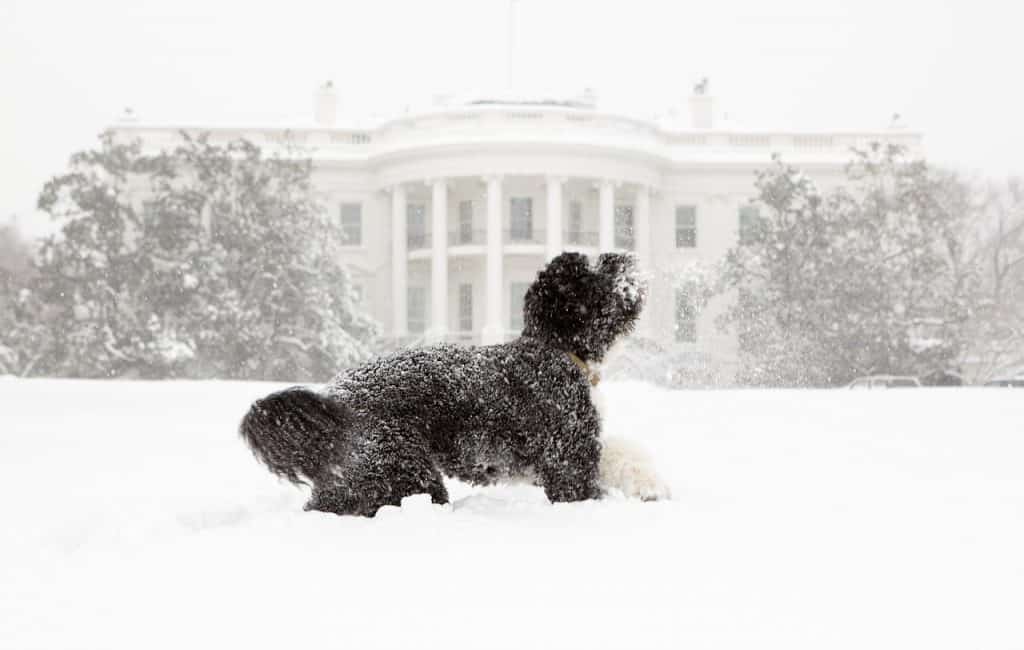
Temperament: These athletic dogs are affectionate, adventurous, and loyal.
Height: Males are 20 to 23 inches, and females are 17 to 21 inches.
Weight: Males are approximately 42 to 60 pounds, while females are 35 to 50 pounds.
Lifespan: Average lifespan is 11 to 13 years.
Breed characteristics: The Portuguese Water Dog has thick curly fur, a medium build, and was explicitly bred to help fishermen. They make excellent waterdogs and are great on boats and other floating vehicles.
Not only are they physically perfect for joining you on your kayaking adventures, but they are also very loving and much easier to train than most breeds. This is our top pick out of all the best dogs for kayaking.
Exercise Requirements: This dog is happy with any kind of activity as long as they are given enough exercise throughout the day.
Training Requirements: This is a highly intelligent breed, which means they can sometimes think independently, and this might cause training to take slightly longer, but they love to please and work hard to learn.
Brittany
Temperament: These upbeat dogs are smart, quick on their feet, and love to please.
Height: The average breed height is 17.5 to 20.5 inches.
Weight: The breed weight is between 30 and 40 pounds.
Lifespan: Average lifespan is 12 to 14 years.
Breed characteristics: This adorable medium dog breed loves following directions, learning, and playing in the water.
The Brittany is loyal, fun-loving, and happy, which makes them great for family dogs as well as adventure buddies.
Their small stature makes them ideal for fitting on a solo kayak.
Exercise Requirements: These dogs are best for owners who are frequently outdoors and doing activities like hiking and camping. They require a significant amount of daily exercise.
Training Requirements: This dog loves to learn everything (e.g., agility, obedience, hunting, swimming, etc.), and they are easy to teach.
Australian Cattle Dog
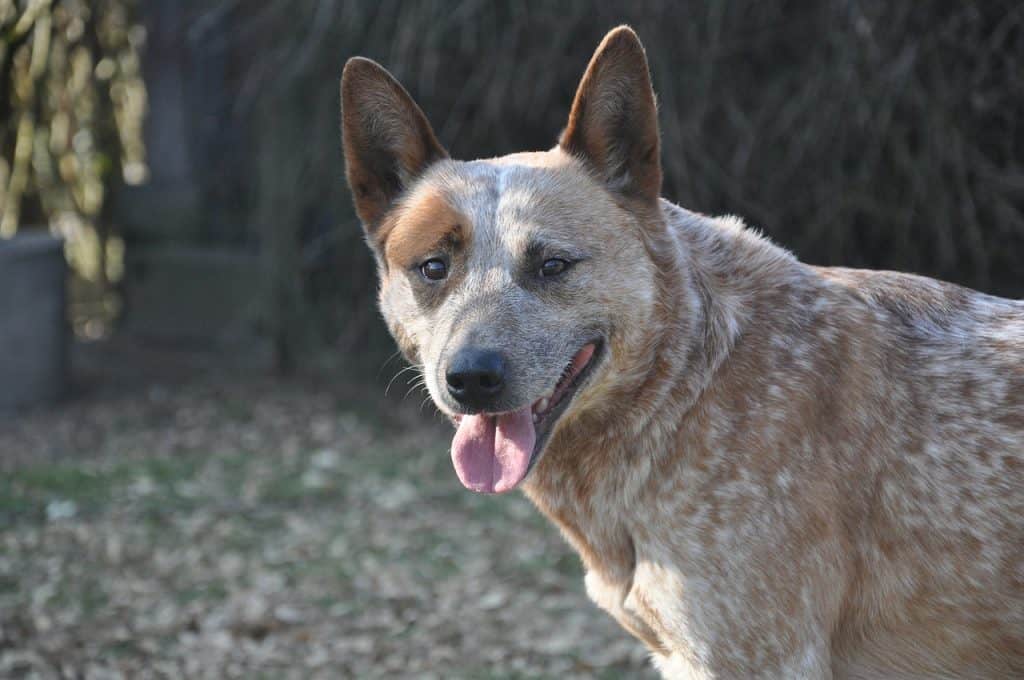
Temperament: These loving dogs are always on alert, intelligent, and loyal.
Height: Males are 18 to 20 inches while females are 17 to19 inches.
Weight: Breed weight is between 35 and 50 pounds.
Lifespan: Average lifespan is 12 to 16 years.
Breed characteristics: The Australian Cattle Dog is also known as the Blue Heeler and Red Heeler. They are bred to be a herding animal, but are exceptionally intelligent, athletic, and love to learn.
They are easily bored when left to their own devices and tend to be chewers unless provided something engaging to do.
They like to stay busy, and this makes them ideal for outdoor recreational activities like kayaking. Their short, thick fur is also water-resistant.
Exercise Requirements: These dogs require a lot of attention, daily runs, and are best on a ranch or other large spaces where they can indulge their herding nature.
Training Requirements: This dog requires socialization training at a young age. They are incredibly smart, fast to learn, and love to please.
When introducing them to the kayak, it might be best to take it slow as they can be hesitant in unknown situations.
Familiarizing them with the kayak and the water before combining the two will make training easier.
Nova Scotia Duck Tolling Retriever

Temperament: This outgoing dog is affectionate and smart.
Height: Males are 18 to 21 inches while females are 17 to 20 inches.
Weight: Breed average between 35 and 50 pounds.
Lifespan: Average lifespan is 12 to 14 years.
Breed characteristics: The Nova Scotia Duck Tolling Retriever is fast, tireless, and friendly. They love to play and were bred for duck hunting, so they do well in the water.
Their small stature makes them a great size for fitting into shorter kayaks.
Exercise Requirements: A thirty-minute walk or playing catch for a half-hour outside is enough exercise to keep these dogs healthy and happy.
Training Requirements: These dogs are stubborn, sensitive, and curious. Being patient and consistent while keeping their attention focused on the task at hand (e.g., with treats, etc.) will be necessary when training.
Short training sessions that are fun and end upbeat are best for teaching this breed.
Training Your Dog to Kayak
Before working towards training your dog, you will want to familiarize yourself with the local and state laws regarding kayaking with passengers (including pets).
There are no national laws stating that dogs cannot be on boats or other floating vehicles, but some local regulations may apply.
Once you start training, patience, and consistency are the key ingredients when it comes to teaching your pet how to enjoy kayaking.
Once you have all the gear that you will need, then comes the time to start familiarizing them with wearing it. Usually, the hardest part is getting them familiar with taking it on and off.
You want them to feel comfortable moving around in the flotation vests before even introducing them to the kayak.
Familiarizing Them With Your Kayak
Before getting in the water, let them sit inside the kayak, and you can move it around to get them used to how it will move when rocking in the water.
While doing this, praise and reassure them while allowing them to sniff and explore the kayak. This is also a great chance to determine if your dog’s breed is the right size for a single or tandem kayak.
Once they are familiar and calm when sitting in the kayak, then you can move it out into open water.
Start On Shore and Then Move to Placid Water
Try getting your dog used to sitting in a boat, and if you have deck grips, you can have more adventurous breeds try getting in and out of the boat until you feel comfortable moving further out into deeper water.
It is best not to kayak with dogs on choppy water, and instead, you want to stay in placid water like lakes or slow-moving rivers.
This is especially true during the first few trips when your dog is still acclimating. Reward your dog for good behavior.
Teaching Your Current Dog(s) to Kayak
Anyone who has a dog already and wants to try teaching them how to get used to riding in a kayak they do not have to be one of the breeds listed above. It is possible that they may never take to the sport, but it does not hurt to try.
The training will match that of a brand new dog, but you will have the benefit of being familiar with your pet’s quirks and preferred rewards, which can help speed up the process.
